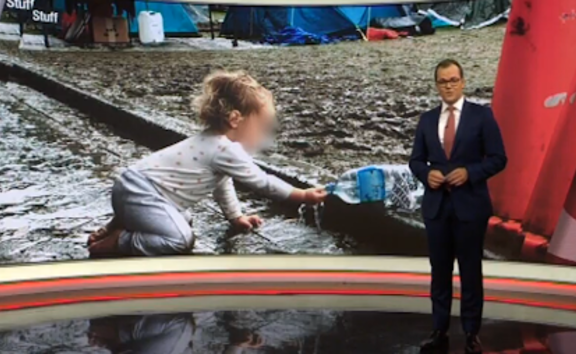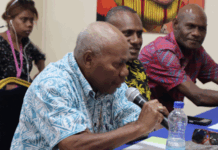
There was plenty of condemnation of New Zealand’s illegal occupation of Parliament in the media at first — but this week some media painted a much more palatable picture of the protesters and their motivation.
However, those who track the far-right and the media channels they use warn that ignores and obscures the protest’s dark undercurrents.
When the convoy converged on Parliament last week, Newshub vox-popped Wellingtonians who called the protest “ridiculous and disruptive”.
When the convoy converged on Parliament last week, Newshub vox-popped Wellingtonians who called the protest “ridiculous and disruptive”.
Offshore, Al Jazeera’s headline quoted residents who called the protesters “‘stupid’ and ‘selfish’”.
Many in the media were at pains to point out the protesters were not just a minority, but a mere fraction of the anti-vax element.
There was also sympathy for the police being confronted by angry and aggressive crowds — and public anger about children being there, even through a record-breaking wet southerly blast and the Speaker’s sprinkler stunt last weekend.
Media highlighted unpleasant conditions
And as the occupation dragged on, media highlighted increasingly unpleasant conditions underfoot.

“The [police] superintendent described the situation as squalor,” TVNZ’s 1News viewers were told last Monday.
“He said there’s faeces on the ground and children are playing in the mud.”
That amplified calls for the convoy crowd to stop blocking the streets — and the drains.
But Newstalk ZB’s political editor Barry Soper told listeners the poo problem was a fiction.
“There’s no faeces anywhere. They’ve got portaloos down there,” he said.
Soper went on to tell ZB’s Drive host Heather du Plessis-Allan the protesters were not as bad as they had been painted.
“They’re Kiwis. A lot of them have been mandated out of their jobs,” Soper said.
‘Do they have a point?’
“Do they have a point?” du Plessis-Allan asked rhetorically.
“Yes they have a point. They insist this is an anti-mandate protest and reporters on the ground say this appears to be the case. Now don’t confuse anti-mandate with anti-vax,” she warned listeners.
In fact, many reporters on the ground stressed that vaccine misinformation seemed near-universal among the occupiers — and amplification of irrational rhetoric, nooses, calls to “hang em high” and Nuremberg imagery were plain to see.
On the same ZB show soon after, NZME head of business Fran O’Sullivan said it was time to engage with them — even though there were no publicly-acknowledged leaders or mainstream political backers at that point.
“Not all people on that lawn are crazy. There’s a lot of people who are pretty ordinary folk who for one or another reason find themselves out of jobs,” she said.
Several commentators declared they were impressed by the pop-up infrustructure and support for what had earlier been described in the media as a leaderless and random occupation.

ZB’s Mike Hosking told listeners of his show the convoy deserved credit.
“I admire people who want to give up a lot of time and travel and hunker down and presumably get some sort of sense of personal accomplishment,” he said.
‘Too many nutters’
That’s quite a shift from the previous Friday, when Hosking dismissed the occupation as a waste of time with “too many nutters, and too many angry people”.
“Didn’t work. Protests make a point — but this one just pissed everyone off,” he said.
Back in 2019, he condemned those occupying Ihumātao as time-wasters too.
“Is it time in lieu you think they’re taking or annual leave they’re taking?” he said.
Politics lecturer and pundit Dr Bryce Edwards told ZB aggression at the protest had evaporated. He described protesters as merely “eccentric”.
The same day Edwards also told RNZ’s Morning Report the protesters had been unfairly smeared as “far right” — even though far right material and broadcasts were still clearly present at the protest.
“Bryce is quite wrong to gloss over the far right influence,” countered another commentator on Morning Report, academic Morgan Godfery.
Known far-right figures were among the first setting up and attending fresh occupation protests in Christchurch.
Watching their channels
Byron C Clark, who researches New Zealand’s far-right and conspiracy theory scene, told Mediawatch that reporters and commentators declaring the protest peaceful and reasonable were ignoring some of its dark undercurrents.
“If you want a full picture, you need to be engaging with people on the ground but also be in the social media channels and watch their own media,” he said.
Extreme and sometimes violent messages are still being posted on apps like Telegram, and media channels like Counterspin, he said.
“They are talking to people who are saying different things to what they say to mainstream media journalists.”
TVNZ’s Cushla Norman also confronted Counterspin frontman Kelvyn Alp orchestrating the coverage outside Parliament last week. In a story that aired on 1News on Thursday TVNZ’s Kristin Hall found messages in stark conflict with the peaceful vibe many of the protesters were projecting publicly.
Protesters have been asking me all week for “evidence” of volatility towards the Wellington public so here it is. https://t.co/mhJNcXlMrF
— Kristin Hall (@kristinhallNZ) February 19, 2022
“The Nuremburg 2.0 trials have started, why is no one reporting on that? You know, that’s the crimes against humanity and treason,” one protester told her.
Hall also pointed to Counterspin’s Kelvyn Alp telling ACT leader David Seymour he was “lucky they haven’t strung [him] up from the nearest bloody lamppost” after offering to mediate.
Common alt-right messages
Clark said those kinds of messages were common in parts of the movement.
“It’s not the case that everyone at the protest is a committed member of the alt-right movement, but it’s certainly the case that the alt-right has a presence in this movement and is trying to influence the direction it takes,” he said.
‘“On Telegram we’ve got people calling for trials and executions of politicians. On Counterspin Media, the hosts are telling people to read the Protocols of the Elders of Zion. To not report on that almost seems like part of that disinformation at this point in time.”
Many protesters identified as liberal or progressive, while being increasingly influenced by extreme content, Clark said.
“You might be skeptical of vaccines for left-wing reasons. You might be distrustful of the pharmaceutical industry. Then when you go into these anti-vax groups online, you’re going to be experiencing conversations about other conspiracy theories, and people will be saying, ‘yes, the media is lying to you, not just about this but also about these other things’.”
“You’re going to be influenced by a lot of these ideas and even if you continue to call yourself a liberal or left-wing, if you’re going to these protests that are shaped by the far-right, are you part of a far-right movement without realising it? I think that’s the case with a lot of the protesters,” he said.
‘Research these fringe elements’
Clark said the convoy was the culmination of years of activity on social media channels like Telegram, where thousands of people were still being radicalised.
He urged reporters to follow his lead and infiltrate those channels, so at the least they are not surprised when another movement emerges.
“I think some of our newsrooms should be putting more resources into researching these groups. Researching these fringe elements. Because we should know after Christchurch in 2019, it doesn’t mean it’s not going to burst out into the real world,” he said.
“These thousands of people have all been chatting to each other on Telegram for months if not years — so this wasn’t something that nobody saw coming. But it’s something the media is struggling to come to terms with,” Clark told Mediawatch.












































